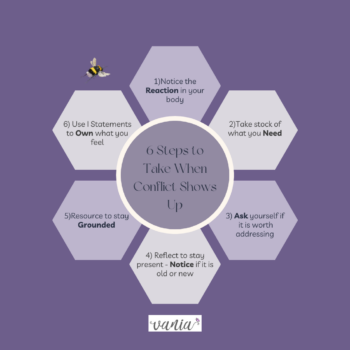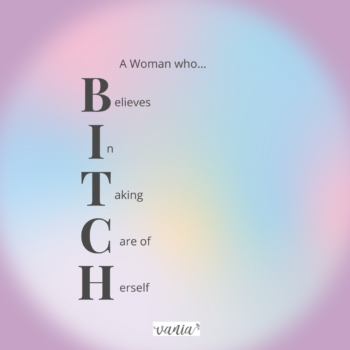Recently, i was involved in a small conflict with someone at work. As a sole entrepreneur, this doesn’t happen a lot these days. In fact, this doesn’t happen in my life in general. It highlighted for me that even though i may be a therapist who specializes in healthy relationships, boundary work, and communication skills, i am also a work-in-progress. I am not exempt from conflict or making a mistake.
This incident was medicine for me as it really helped me take stock of how far i have come, and the work that is yet to be tended to. In some ways, starting the year off with this is a great reinforcement of my commitment to my Word of the Year: Embrace.
I need to embrace that conflict is a natural aspect of being human because we will be faced with people who have competing ways of tending to their needs. This is a reminder to all of us that anger and conflict are not inherently bad, rather it’s how we respond to it that matters.
I won’t go into the depths of what happened here. Rather, what stood out for me was how i handled myself and what i gleaned from the person who had a competing need.
To start, i was able to reflect on how i have evolved in my personal relationship with conflict. I grew up in a home where my needs were not heard, and i felt that they didn’t matter. Having a voice and opinion was something that took many years to grow. I, like most people, am conflict avoidant most of the time. I am not averse to it because when i am able to notice my needs, i can get into the messiness and still address what it is i need, even if it is flawed.
It’s one thing to know that you have needs and that they matter. What is also necessary to be the steward of said needs is to have skills to handle conflict or competing needs that will inevitably happen.
I did not grow up with the best models of conflict resolution skills. In fact, i felt afraid by my parents’ anger and difficulty to tend to their own emotions. I learned that walking on eggshells was not just a practice but a survival skill and it has taken me years to evolve from that trauma response. With that in mind, i have had to do a lot of work to heal from my childhood as well as update my skillset around conflict. It can be hard to not regress when we are with our families of origin, especially when the work is not reciprocated. So, when my dad’s default of attack and then withdraw tactics get activated, i have to work hard to stay grounded. I have to hold two truths – that his childhood context will always be in the room with us, and i know how to take care of myself now.
A good place to start when you are wanting to evolve your relationship with conflict is to remember that it is tethered to how often we are up against wounded Parts, not necessarily our best Self. Conflict happens when protectors come online inside us, and we are in conflict with flawed yet well-intentioned Parts of other people. Our parts are in the conflict – not our most evolved Selves.
Because i did not feel safe with my needs or standing up for myself, a Part of me used to come online whenever i was in conflict. She was my Inner People Pleaser. She later grew up to be sassy and a bit of a dragon because i so desperately wanted to stand up for myself. But what i lacked was the skills to stay rooted and assertive – i became passive aggressive instead. I knew i didn’t want this but it was a way to not stay stuck – my new-found Inner Warrior was also not wise enough to notice the impact i had on others.
Working on this really helped me be mindful of how experiencing conflict felt in my body – i got hot in my core as well as wanted to bow my head down, or be deferential. I would have shallow breaths that inhibited my ability to say something – to speak up. My whole body got in my own way in fact. Through somatic healing work, i was able to attune to this and have more clear mindfulness when this response showed up in me.
We are all works-in-progress as humans: We are supposed to be. One thing i have learned is what i need to stay present during a conflict. I’ve noticed that having steps and a path is really helpful for me because it acts as a guide and keeps me grounded as well as attuned. Here is what i have come up with: 1)Notice your Reaction in your body 2)Take stock of what you need 3)Ask yourself if it is worth addressing – what is at stake? 4)Reflect to stay Present – is this old or new? 5)Resource with skills and self-soothing to help stay grounded and 6)Use I-statements so you can be objective and not reactionary. What these steps do is help me slow down – and not reactive but rather respond with a mindful awareness. I have been catching myself do this more and more when with others, and it need not take more than a few minutes – we DO have time to to do this, i promise you.

It is also important after a conflict occurs to process what happened and your role in. Remember, it take two to tango so there will also be something you did that contributed. The lesson is to learn from your contribution, even it is unintentional – to make you a better human. So, make time after a conflict (remember they are inevitable after all) to 1)Reflect on what happened and what you could do differently and 2)Forgive yourself and accept you are not responsible for others’ feelings.
When we take time to do this, we remove any residual baggage of misaligned guilt and it keeps us moving forward with intention. This is one way i have been standing up for myself instead of self-abandoning my needs. Surely, it is not easy especially after a lifetime of people pleasing and fawning. That’s why one other important resource is to learn the difference between belonging, fitting in or fawning for safety.
In a recent I’m Not Your Shrink podcast episode, Dr Tracy Dalglesih speaks about the polarity between giving up ourselves so that we are not abandoned or rejected by others. We will do whatever we need to fit in or fawn towards someone. This is a safety need, that stems from our nervous system. We are social creatures and being in community is a survival skill. It was built to keep us safe and now our job is to discern if the danger is real or not. Anyone with unhealed relational trauma may have a harder time addressing their needs because it may put our relationship at risk. Dr. Tracy goes on to share the concept of Differentiation: where we can get a felt sense of separating someone else’s needs from our own, instead of being stuck in enmeshment: The antidote to self-abandonment is the practice of differentiation.
Someone i support recently told me that i am the Queen of the Reframe and i am boldly claiming that title. I don’t love demeaning and pejorative words to describe someone. I find them violent and discriminatory, reductive and slamming. And yet, i do love the reparative work of reclaiming words. For instance, many moons ago, i learned the reframe of the word BITCH – a woman who Believes In Taking Care of Herself. And so, sometimes when i notice i am upset about something that someone did that impacted me, this word is a perfect tool to help me notice the impact on me: A boundary was violated and my anger is actually a proportional response. Even that is huge – my anger can be a valid and understandable response.

I am a social creature who thrives off connection and relationships. So it makes sense that I may not want others to use that term against me, or call me selfish. And yet, i think what makes these labels unhelpful is that the person using them doesn’t also reflect on what they have done to cause my reaction. It gives them an excuse to not do their own work of critical self-reflection. So a huge part of this journey with conflict for me has been embracing (see what i did there) that i am not responsible about what others think about me. I am also okay with accepting that not everyone will like me. This is especially true when it comes to being proud of my truth and the boundary i placed with them.
This is the golden ticket for me as i am maturing into adulthood: I would rather disappoint someone else because my need matters to me, instead of having regret for not speaking up. This is one way we can work on not abandoning ourselves. For many of us (especially women), this has been a hard truth to come to. Our inner people pleasers and Good Girls struggle to put our needs first, let alone on the table at all, if it means having someone be upset with us. And yet, if it means that every time i revisit the argument later or am faced with it again, a little part of me holds shame and resentment. This is not the way i want to live. I am moving on from my Inner People Pleaser and Good Girl. Yes, it’s been messy at times, but it’s also been reparative, transformative, and is getting me back to honouring my own needs.
What is this really about? We need to zoom our lens out from what we think the problem is. It may not be what’s right in front of you: It isn’t necessarily about the parking ticket or table in the office, but rather old wounds that have become a pattern for us. Often, it is around an attachment rupture or confrontation that someone is putting their own need above mine. In her book, Break the Good Girl Myth: How to Dismantle Outdated Rules, Unleash Your Power, and Design a More Purposeful Life, Majo Molfino shares more insight into this as well as great ways to evolve from our Inner Good Girl. It includes a self-care plan as well as unpacking the myths of sacrifice and perfection.
Another helpful healing practice is to get to know what Healthy Aggression feels like. Remember, our felt sense of anger is a message from ourselves that a boundary we need was violated or minimized. I like to think of this inner knowing as my Inner Warrior coming online. She is wild and also has healed from the attack mode she used to need. Kimberly Ann Johnson has been a teacher for me about this. In her book, The Call of the Wild: How to Heal Trauma, Awaken our Inner Power, and Use it for Good, she shares that it is imperative to have a felt sense of our boundaries: It’s not enough to just think our way through this work. We also need to reclaim our right to bear our teeth a little, even if it’s just in front of our mirror. These somatic resources can be a great support to help us adapt with healthy maturation.
I do this healing process in incremental steps, so that both my mind and body are in agreement. That means, i work to own my feelings with I-statements. I have a simple somatic practice called Strong Back Soft Heart to hold space for my needs with a Strong Back, and also the feelings of the other person with a Soft Heart. When we hold our own needs with the same level of respect as how we hold other’s, even if the outcome isn’t 100% our dream ending, we can feel at peace with it.
As I’m embracing my mid-life emergence, that means also reclaiming that i will get upset with others because we cannot always have aligned goals or needs. Moving into the Virgin era of my life means embracing the gift that comes with old(er) age – i don’t have to care what others think about me anymore. I don’t have to accept the role they want me to play for them. While a part of me can’t wait for that to be fully embraced, i know that i still have work to do in order to integrate these parts to be more humane and respectful even when i disagree with others.
So, i will let myself roar – i will not silence myself anymore. I just won’t do it with a fire but rather a soft fierceness.


